
A machine pistol is an autoloading pistol capable of fully automatic fire, including stockless handgun-style submachine guns.

The Colt M1911 is a single-action, recoil-operated, semi-automatic pistol chambered for the .45 ACP cartridge. The pistol's formal U.S. military designation as of 1940 was Automatic Pistol, Caliber .45, M1911 for the original model adopted in March 1911, and Automatic Pistol, Caliber .45, M1911A1 for the improved M1911A1 model which entered service in 1926. The designation changed to Pistol, Caliber .45, Automatic, M1911A1 in the Vietnam War era.

The M4 carbine is a 5.56×45mm NATO, gas-operated, magazine-fed carbine developed in the United States during the 1980s. It is a shortened version of the M16A2 assault rifle.
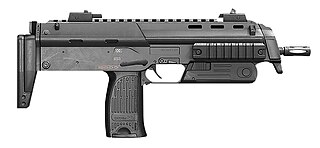
The Heckler & Koch MP7 is a personal defense weapon chambered for the HK 4.6×30mm armor-piercing cartridge designed by German defence manufacturer Heckler & Koch.

Knight's Armament Company (KAC) is an American firearms and firearms parts manufacturer, best known for producing the Rail Interface System (RIS) and the Rail Adapter System (RAS) grips for firearms use. They currently produce a variety of firearms, specifically AR-15 rifles.
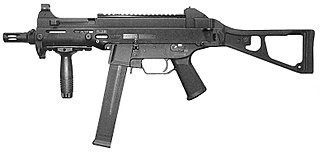
The Heckler & Koch UMP is a submachine gun developed and manufactured by Heckler & Koch. Heckler & Koch developed the UMP as a lighter and cheaper successor to the MP5, though both remain in production. The UMP has been adopted for use by various countries including Brazil, Canada, and the United States. A small number of UMPs chambered in .45 ACP were officially purchased by the 5th Special Forces Group of the United States Army Special Forces, with some of the weapons seeing limited service in the early years of the Iraqi insurgency, making them one of the more popular submachine guns being deployed by the U.S. military personnel in recent conflicts around the world.

The Ultimax 100 is a Singapore-made 5.56mm light machine gun, developed by the Chartered Industries of Singapore by a team of engineers under the guidance of American firearms designer L. James Sullivan. The weapon is extremely accurate due to its constant-recoil operating system and is one of the lightest machine guns in the world.
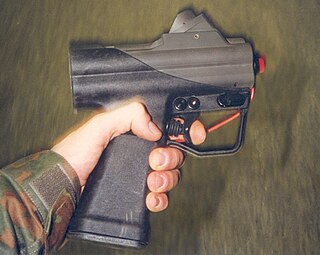
The Heckler & Koch P11 is an underwater firearm developed in 1976 by Heckler & Koch. It is loaded using a pepper-box-like assembly, containing five sealed barrels each containing an electrically-fired projectile. Two styles of barrel assembly can be used: one containing five 7.62×36mm flechette darts for use underwater, or five 133-grain bullets for use above water.
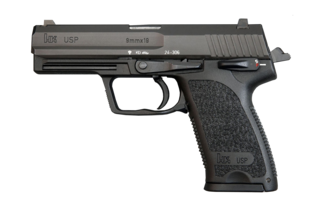
The USP is a semi-automatic pistol developed in Germany by Heckler & Koch GmbH (H&K) as a replacement for the P7 series of handguns.
The FNSCAR is a family of gas-operated short-stroke gas piston automatic rifles developed by Belgian manufacturer FN Herstal (FN) in 2004. It is constructed with modularity for the United States Special Operations Command (SOCOM) to satisfy the requirements of the SCAR competition. This family of rifles consists of two main types. The SCAR-L, for "light", is chambered in 5.56×45mm NATO and the SCAR-H, for "heavy", is chambered in 7.62×51mm NATO. Both types are available in Close Quarters Combat (CQC), Standard (STD), and Long Barrel (LB) variants.

The Heckler & KochP7 is a German 9×19mm semi-automatic pistol designed by Helmut Weldle and produced from 1979 to 2008 by Heckler & Koch GmbH (H&K). The P7M13, a variant of the P7 with a double-stack magazine, was produced until 2000.

The AN/PEQ-6 Integrated Laser Light Module (ILLM) is a laser aiming module (LAM) designed and manufactured by Insight Technology for use by United States Special Operations Command (USSOCOM) with the Heckler & Koch Mark 23 semi-automatic pistol and a Knight's Armament Company suppressor; the whole system is designated the Mk 23 Mod 0 Offensive Handgun Weapon System.
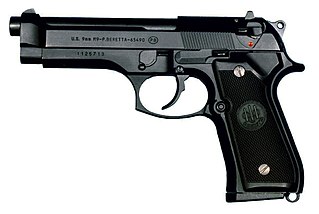
The Joint Combat Pistol was the name for a former US program for a new military sidearm to replace the M9 Pistol, extant from late 2005 to early 2006. The program was started in 2005 and run by USSOCOM. It was the result of a merger of two earlier programs, the army's Future Handgun System (FHS) and the Special Operations Forces Combat Pistol. Requirements for the JCP included being chambered for caliber .45 ACP, having an integrated Picatinny rail, including day/night sights, and being capable of accepting a suppressor.

The HK4 is a pocket pistol, first introduced by Heckler & Koch in either 1964 or 1967. It was distinctive for allowing shooters to swap barrels chambered for different cartridges without tools and for having a durable but light hard-anodized aluminum-alloy frame.
The Colt OHWS was a semi-automatic pistol created by Colt to compete for the United States Special Operations Command Offensive Handgun Weapon System (OHWS) tender. The winner of this competition would become the standard-issue handgun for most US special forces groups. The OHWS contract was awarded to Heckler & Koch for their MK23 Mod 0 pistol, and Colt scrapped the project.

The Joint Service Small Arms Program, abbreviated JSSAP, was created to coordinate weapon standardization between the various United States armed service branches.

The Heckler & Koch HK45 is a semi-automatic pistol designed by the German arms manufacturer Heckler & Koch.
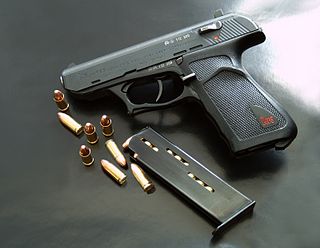
The HK P9 is a semi-automatic pistol from Heckler & Koch in 9×19mm Parabellum, .45 ACP, and 7.65×21mm Parabellum and the first to use a variation of H&K's roller delayed blowback system in a pistol format and polygonal rifling now common in H&K designs.

The Heckler & Koch VP9 is a polymer-framed semi-automatic striker-fired handgun. The VP designation in the name refers to Volkspistole, which translates to "people's pistol", while SFP stands for "striker-fired pistol". The 9 stands for the caliber designation of 9 mm. The VP9 is the third striker-fired pistol that HK has produced. A variant of the VP9, the VP40, is chambered for .40 S&W; the VP40 is known as SFP40 in Europe and Canada.
















